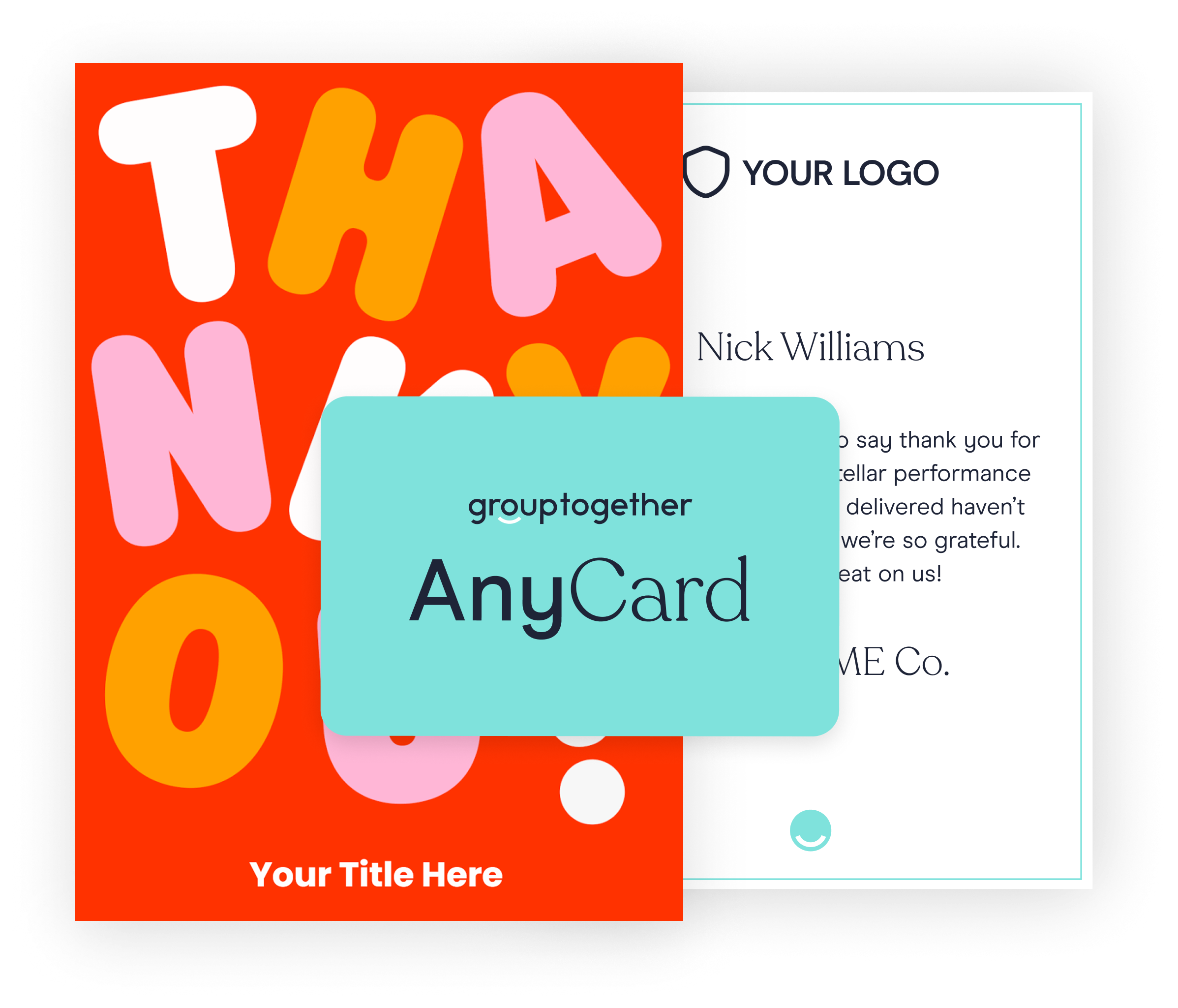Ali + Julie
Co-Founders, GroupTogether
Life’s busy. That’s why we’re here to make it easy for you to collect money from a group. Less wasted time, less packaging waste, and spending a little less but giving a lot better!
🎁 Send employees a holiday eGift Card & greeting card in minutes. Get started.
Share
Employee recognition programs are key to driving engagement and reducing turnover. Here we explore best practices and benefits.
By Ali + Julie
September 18, 2025

Winning with employee recognition programs
Recognised employees = engaged & loyal employees
Types of employee recognition programs
Get inspiration from top companies
Tips for the best employee recognition programs
Challenges in implementing employee recognition programs
Driving boosted satisfaction with recognition
Is your team driving results? Kicking goals? And generally hustling for your organisation? If so, you want to reward and recognise their efforts.
Employees who feel appreciated are unsurprisingly happier and more likely to stay at their company. Surprise, surprise! But let’s chat specifics – how do you run a program that’ll have a genuine impact? We’ve rounded up the top tips.
Okay, spoiler alert. Being recognised and appreciated kinda counts for a lot. There’s nothing worse than working tirelessly to hit deadlines, meet KPIs and drive innovation, then feeling like that hard work is completely overlooked.
Employee recognition doesn’t just make a difference to employee satisfaction – it flows into all the key metrics. We’re talking engagement, productivity and attrition.
In short: it’s not just important – it’s essential.
Would you be highly engaged in a company you felt didn’t care about you? Us neither.
It’s hard to get motivated and go the extra mile when you feel as though all that hard work is for nothing. And the stats unsurprisingly line up with that sentiment.
Appreciated employees are more likely to be satisfied, engaged in their role and stick with your organisation.
So, if you want your team to show up, roll up their sleeves and deliver great work – you’ve got to show you care and appreciate what they do.
It’s simple then! Appreciate employees, recognise their efforts and they’ll be more likely to do great work and stay with your company. Win, win.
That’s all well and good. But… how do you implement a program with max impact and the longevity to last for the long haul?
We’ve got you covered.
First up: consider the type of employee rewards and recognition program you could implement at your company.
Formal programs are more traditional, structured, company-wide initiatives that have guidelines, criteria and timings.
Think things like:
Pros: Structure means employees are regularly and evenly appreciated across the board.
Cons: Formal programs are rigid and don’t always leave room to bring recognition flexibility into the day-to-day. It can also limit how many people are recognised each year.
Have an employee do something unexpectedly awesome? Informal recognition initiatives offer the flexibility for spontaneous and casual appreciation of great work.
Think things like:
Pros: These provide a quick morale boost and help ensure daily wins aren’t overlooked.
Cons: The ad hoc nature can mean some employees get recognised more than others. It can also lead to missing those whose work isn’t in the spotlight or whose success is more of a slow burn.
Sure, getting a thumbs-up from your boss is always appreciated. But a “you rock” from a teammate can be just as mood boosting.
Facilitating and encouraging peer recognition is a savvy way to promote a friendly culture of support and teamwork across the board.
Think things like:
Pros: These can promote a sense of camaraderie and mateship across the business.
Cons: Peer recognition relies on teammates to put in the effort – something that often falls on a select few.
Want to show someone on your team some appreciation for a job well done? That’s easy with GroupTogether. Loved by office managers and culture champions alike, you can send gift cards to your whole team at once, or collect messages on a group card to show your teammates you care.

Need some inspo? Globally, there are endless companies running employee engagement initiatives to appreciate their employees in fun and unique ways.
Take Google, which has a peer recognition tool, aptly named gThanks. Through gThanks, employees can send virtual notes of recognition that can be seen and liked across the company.
LinkedIn has a similar platform – Bravo – where employees can shout out and celebrate colleague achievements in a public feed.
At Cisco, 1% of the total payroll is used for the Connected Recognition program. Managers and employees are able to gift rewards using the fund to celebrate their teams.
Ohana Rewards at Salesforce is a value-based recognition program that involves peer recognition and awards given to employees.
Now to the nitty-gritty. What are the key steps you can take to implement employee engagement initiatives that will have employees feeling the love? Start with clear goals. Design something that fits your biz. Measure for true success.
Let’s do this!
Always start with a clear objective. Without a goal, there’s no direction and no way to accurately measure success.
Is your aim to boost employee satisfaction? Reduce attrition? Keep employees motivated to do better work?
Get clear on your objectives first before diving in and designing initiatives. Your goal(s) will play heavily into how you proceed.
Next up, design a program that’s going to fit your company and goals. What’s perfect for a creative agency could make no sense in an engineering firm – so take the time to make it right.
In one organisation, an employee program could include:
In another, it could be:
Hot tip: design something that can be easily implemented into day-to-day ops. Like including shoutouts in your daily standups, or creating an appreciation board on a platform your team already uses. That way it’s more likely to stick.
Whatever you decide, put a plan together and get your employee recognition program in writing. This will ensure every team member can see what it is, how it works and understand how to participate.
Are you a chill, creative crew? Or a more formal workplace with polished comms? Your employee recognition program should align with that culture.
A colourful shoutout board with Polaroid pictures could be great for one team, but might be less than ideal in another.
If culture aligns, the recognition will feel more authentic to employees. And that means greater impact.
In an ideal world, you could buy your employees expensive gifts to show you care. The reality is: you probably don’t have the budget. No stress! It’s the recognition that counts, not so much the dollar value.
A program can work on any budget if it’s authentic and well-considered.
When considering costs, set a clear budget and stick to it. Consistency is better than a program that dies off after the budget is burned up too fast.
Out with the guesswork, in with the data. If you want to see what’s truly working, you’ll need to gain feedback.
That means asking your team – via surveys and feedback sessions – what is and isn’t making them feel appreciated. With this feedback, you’ll have the insights you need to get better.
Pivot. Add. Subtract. And continually improve your program for boosted impact.
Want a program you can rely on and run with? Use these key tips to design something that’s going to have staying power – and win with your teams.
A recognition program is a great start. What can make appreciation stick is embedding it into your culture.
When a cultural attitude of gratitude is present, saying things like “thank you”, “you’re awesome,” or “you’ve done a great job here” becomes commonplace.
No prompting or structure needed.
Distributed team? No problem. You don’t need your crew in person to have a program that works.
Whether by email, Slack channels, shout-outs on video calls, online greeting cards or digital gift cards, there are endless ways to run a program digitally. And still have employees feeling recognised.
Recognition doesn’t need to be grand gestures. It can be the small, thoughtful messages that count too.
Small wins – like a well-timed email, thoughtful handwritten note or personalised card – are simple to implement and have longevity.
Recognising employees is the gold standard. But recognition programs don’t come without roadblocks.
Getting things rolling can be challenging – especially if some parties aren’t on board. Here are some ways to avoid falling into common pitfalls.
If only some team members participate, recognition can be inconsistent. And if it feels like only some of the crew are being appreciated, it can lead to even worse satisfaction for those who aren’t.
Avoid inconsistency by embedding any program across the business. Ensure all employees have a chance to be recognised and that all teams are on board.
Okay, so you’ve put a plan together – and it’s foolproof. Only challenge is… none of your managers are buying into the idea. Ugh!
Without buy-in from key leaders, any recognition program is likely to disappear.
To get managers on board, bring them in from the beginning and explain the program's value (ideally with some data proof around productivity, morale and attrition) to help motivate involvement.
According to Gallup research, employee recognition needs to feel authentic to count. Employees who strongly agree that the recognition they receive is authentic are seven times more likely to report that they’re treated with respect at work!
Vague notes like “thank you for your service” can come off as meaningless. Instead, boost that authenticity by getting into the specifics – by naming the project, win or attribute you’re celebrating – to make things feel genuine and personalised.
While it’s great to shout out people regularly, you don’t want to overdo it. If recognition is over-the-top, it can lead to fatigue and blown-out budgets. Yikes!
Create a plan with longevity to benefit your crew over the long haul.
It’s no secret; managers are often busy. Spinning plates and endless priorities means recognition programs can get overlooked. That’s why it’s essential to make recognition a company-wide experience.
Peer-to-peer recognition means those good vibes are still flowing even when managers are slammed.
If your crew is hitting goals and smashing those KPIs, they want to feel appreciated for it. After all, there’s nothing like that dopamine boost after being recognised for the hard work you put in.
A little recognition – whether it’s via email, a virtual whiteboard, a card celebrating a win or an award program – can go a long way. And happy employees are more likely to stick around and shine while they do.
Want a simple way to recognise employees? A group card makes it easy to celebrate your colleagues with heartfelt messages and a meaningful gift – all in one link. It’s a simple way to strengthen culture and keep great people around. Or, send digital gift cards to your whole team in just a few clicks. Personalise their message and card for a thoughtful touch.
Ali + Julie
Co-Founders, GroupTogether
Life’s busy. That’s why we’re here to make it easy for you to collect money from a group. Less wasted time, less packaging waste, and spending a little less but giving a lot better!


How To
Everything You Need to Know About the GroupTogether AnyCard

Card Message Inspo
What to Write in a Boss’s Day Card (and What Not To!)

Gift Ideas
The Ultimate Guide to Boss’s Day 2025

Gift Ideas
Best Restaurant Gift Cards & Dining Vouchers in Australia

 Australia
Australia
 USA
USA
 Canada
Canada
 United Kingdom
United Kingdom
 Rest of World
Rest of World
Cool! You can create a Group Card. You just can’t do collections or eGift Cards.
Continue